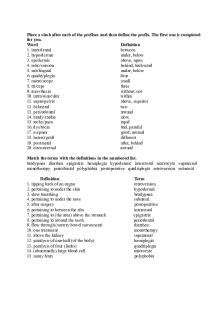Chapter 2 - Medical Term - The body Structure PDF

| Title | Chapter 2 - Medical Term - The body Structure |
|---|---|
| Course | Medical Terminology |
| Institution | University of West Florida |
| Pages | 5 |
| File Size | 207.2 KB |
| File Type | |
| Total Downloads | 84 |
| Total Views | 156 |
Summary
Medical Term - The body Structure...
Description
Word Parts aden/o gland adip/o fat anter/o before, front caud/o lower part of body, tail cephal/o head cyt/o, -cyte cell end-, endo- in, within, inside exo- out of, outside, away from hist/o tissue -ologist specialist -ology the science or study of path/o, -pathy disease, suffering, feeling, emotion plas/i, plas/o, -plasia development, growth, formation poster/o behind, toward the back -stasis, -static control, maintenance of a constant level
In medical terminology, there are several additional ways to describe the location of different body parts. These anatomical reference systems include: Body planes Body directions Body cavities Structural units
The different cavities. The dorsal cavity, which is located along the back of the body and head, contains organs of the nervous system that coordinate body functions and is divided into two portions:
The cranial cavity, which is located within the skull, surrounds and protects the brain. Cranial means pertaining to the skull.
The spinal cavity, which is located within the spinal column, surrounds and protects the spinal cord.
The Ventral Cavity The ventral cavity, which is located along the front of the body, contains the body organs that sustain homeostasis. play audio Homeostasis (hoh-mee-oh-STAY-sis) is the processes through which the body maintains a constant internal environment (home/o means constant, and -stasis means control). The ventral cavity is divided into the following portions:
The thoracic cavity (thoh-RAS-ick), also known as the chest cavity or thorax, surrounds and protects the heart and the lungs. The diaphragm is a muscle that separates the thoracic and abdominal cavities. The abdominal cavity (ab-DOM-ih-nal) contains the major organs of digestion. This cavity is frequently referred to simply as the abdomen (AB-doh-men). The pelvic cavity (PEL-vick) is the space formed by the hip bones and contains the organs of the reproductive and excretory systems.
A tissue is a group or layer of similarly specialized cells that join together to perform certain specific functions. play audio Histology is the microscopic study of the structure, composition, and function of tissues (hist means tissue, and -ology means a study of). A histologist is a non-physician specialist who studies the microscopic structure of tissues (hist means tissue, and -ologist means specialist). The four main types of tissue are as follows: Epithelial tissue Epithelial tissue forms a protective covering for all of the internal and external surfaces of the body. These tissues also form glands.
Epithelium is the specialized epithelial tissue that forms the epidermis of the skin and the surface layer of mucous membranes. Endothelium is the specialized epithelial tissue that lines the blood and lymph vessels, body cavities, glands, and organs.
Connective tissue Connective tissues support and connect organs and other body tissues. The four kinds of connective tissue are as follows:
Dense connective tissues, such as bone and cartilage, form the joints and framework of the body.
Adipose tissue, also known as fat, provides protective padding, insulation, and support (adip means fat, and -ose means pertaining to).
Loose connective tissue surrounds various organs and supports both nerve cells and blood vessels.
Liquid connective tissues, which are blood and lymph, transport nutrients and waste products throughout the body.
Muscle tissue Muscle tissue contains cells with the specialized ability to contract and relax. Nerve tissue Nerve tissue contains cells with the specialized ability to react to stimuli and to conduct electrical impulses....
Similar Free PDFs

Medical Term. Chapter 2 notes
- 2 Pages

Medical term notes 1
- 89 Pages

Medical Term - CLAS 103
- 13 Pages

Med term - medical terminology
- 20 Pages

Medical Term Quiz 2 Study Guide
- 2 Pages

Week 3 Medical Term Assignment
- 2 Pages

Med Term Notes Chapter 2
- 2 Pages
Popular Institutions
- Tinajero National High School - Annex
- Politeknik Caltex Riau
- Yokohama City University
- SGT University
- University of Al-Qadisiyah
- Divine Word College of Vigan
- Techniek College Rotterdam
- Universidade de Santiago
- Universiti Teknologi MARA Cawangan Johor Kampus Pasir Gudang
- Poltekkes Kemenkes Yogyakarta
- Baguio City National High School
- Colegio san marcos
- preparatoria uno
- Centro de Bachillerato Tecnológico Industrial y de Servicios No. 107
- Dalian Maritime University
- Quang Trung Secondary School
- Colegio Tecnológico en Informática
- Corporación Regional de Educación Superior
- Grupo CEDVA
- Dar Al Uloom University
- Centro de Estudios Preuniversitarios de la Universidad Nacional de Ingeniería
- 上智大学
- Aakash International School, Nuna Majara
- San Felipe Neri Catholic School
- Kang Chiao International School - New Taipei City
- Misamis Occidental National High School
- Institución Educativa Escuela Normal Juan Ladrilleros
- Kolehiyo ng Pantukan
- Batanes State College
- Instituto Continental
- Sekolah Menengah Kejuruan Kesehatan Kaltara (Tarakan)
- Colegio de La Inmaculada Concepcion - Cebu








